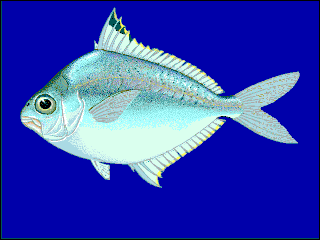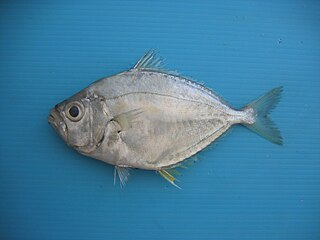
Leiognathidae, the ponyfishes, slipmouths or slimys / slimies, are a small family of fishes in the order Perciformes. They inhabit marine and brackish waters in the Indian and West Pacific Oceans. They can be used in the preparation of bagoong.

Helicolenus is a genus of marine ray-finned fishes belonging to the family Scorpaenidae where they are classified within the subfamily Sebastinae, the rockfishes. The species in this genus are found in the Indian, Atlantic and Pacific oceans.

Tokiharu Abe was a Japanese ichthyologist and a government official of Ministry of Agriculture and Forestry.
Photoblepharon is a genus of poorly understood flashlight fishes found around reefs in the western Pacific Ocean (P. palpebratum) and in the western Indian Ocean (P. steinitzi). Both of its species are nocturnal predators, hiding in caves and crevices during the day and emerging at night to feed. They are small fish, 11.0–12.0 cm (4.3–4.7 in) maximum length, and of little commercial value, although fishermen have been known to use their light organs as bait. Like other anomalopids, they are notable for the white organs containing bioluminescent bacteria underneath their eyes, which, by emitting a blue-green light, allow the fish to search for food, evade predators, and communicate with other fish. Both species have black lids that slide up to cover the organ when the fish does not want to emit light. Although similar in appearance, they can be easily distinguished by the preopercle, which has a medium-sized white spot in P. palpebratum, whereas in P. steinitzi, it is much smaller and much darker, or not present at all. Neither species has been evaluated by the International Union for Conservation of Nature (IUCN) and their nocturnal natures make collection difficult and sightings uncommon.

Deveximentum is a genus of ponyfishes native to the Indian Ocean and the western Pacific Ocean.
Deveximentum hanedai is a species of marine ray-finned fish, a ponyfish from the family Leiognathidae. It isnative to the Indian and Pacific ocean waters around the countries of Thailand, Indonesia and Malaysia. It can be found in marine and brackish waters.

The striped ponyfish is a species of marine ray-finned fish, a ponyfish from the family Leiognathidae. It is native to the Indian Ocean and the western Pacific Ocean, from the Red Sea and the eastern coast of Africa to Fiji and Samoa, where it occurs in coastal marine and brackish waters. It occurs at depths of from 20 to 50 metres. It is a predator upon smaller fishes, small crustaceans and polychaete worms. This species grows to a length of 21 centimetres (8.3 in) TL though most do not exceed 17 centimetres (6.7 in) TL. It is of minor importance to local commercial fisheries. This species is the only known member of its genus.

Equulites is a genus of ponyfishes native to the Indian Ocean and the western Pacific Ocean. Analysis of mitochondrial DNA published in 2017 has suggested that Equulites elongates is in fact a species group made up of three species Equulites aethopos, Equulites elongates and Equulites popei.

Eubleekeria is a genus of marine ray-finned fishes, ponyfishes from the family Leiognathidae which are native to the Indian Ocean and the western Pacific Ocean.

Gazza is a genus of marine ray-finned fishes, ponyfishes from the family Leiognathidae which are native to the Indian Ocean and the western Pacific Ocean.

Karalla is a genus of marine ray-finned fishes, ponyfishes from the family Leiognathidae which are native to the Indian Ocean and the western Pacific Ocean.

Leiognathus is a genus of marine ray-finned fishes, ponyfishes from the family Leiognathidae. They are native to the Indian Ocean and the western Pacific Ocean. They are sometimes known as silverbellies.

Nuchequula is a genus of ponyfishes native to the Indian Ocean and the western Pacific Ocean.

Eubleekeria splendens, common names splendid ponyfish and blacktip ponyfish, is a species of ponyfish.
Photopectoralis aureus, commonly known as the golden ponyfish or false toothed ponyfish, is a marine ray-finned fish native to the Western Pacific from Taiwan south to Indonesia as well as to the Gulf of Thailand, Timor Sea, and the Arafura Sea. It grows to 10 cm (3.9 in) TL. This species was first formally described in 1972 as Leiognathus aureus by the Japanese ichthyologists Tokiharu Abe (1911-1996) and Yata Haneda (1907-1995) with the type locality given as Ambon fish market on Ambon Island. It is the type species of the genus Photopectoralis which was delineated by Sparks, Dunlap & W. L. Smith in 2005.

Leiognathus longispinis, commonly known as the longspine- or Smithurst's ponyfish, is a fish of brackish and marine waters found in the Indian and western Pacific Oceans, from India through Malaysia and Indonesia south to northern Australia and east to the Philippines and Fiji It was described in 1835 by French Zoologist Achille Valenciennes from a specimen caught off Waigeo island in Irian Jaya in New Guinea. In 1886 Ramsay and Ogilby described what turned out to the same species from Hood Lagoon in Papua New Guinea, naming it Leiognathus smithursti. In 2008, ichthyologists Prosanta Chakrabarty and John S. Sparks resurrected the genus Aurigequula and placed L. longispinis and L. fasciatus in it, on the basis of a horizontal row of yellow markings on their flanks and elongated second spine of the dorsal fin. However, a molecular study showed that the genus Leiognathus was nested within Aurigequula, and hence the genera were merged once more. Fishbase places this species in Leiognathus while retaining the striped ponyfish in the monotypic Aurigequula.

Gazza minuta, the toothpony or toothed ponyfish, is a species of marine ray-finned fish, a ponyfish from the family Leiognathidae. It is found in the Indo-Pacific from the Red Sea and the east African coast east through the Indian and Pacific Oceans to Australia and Tahiti north as far as the Ryukyu Islands. It occurs over sandy and silty bottoms, although the young prefer mangroves and silty reefs. it feeds using its protruding pipette-like mouth or using the gill rakers as seives. Its food consists of smaller fishes, crustaceans and polychaetes.

Leiognathus berbis, the Berber ponyfish, is a species of marine ray-finned fish, a ponyfish from the family Leiognathidae. It is found in brackish and marine waters in the Indian and Pacific Oceans from the Red Sea, Gulf of Aden and Zanzibar east in the Indian Ocean to south-east Asia. Like its relatives, the fish is a demersal species that feeds on small crustaceans and bivalves. Equula berbis is considered by some authorities to be nomen dubium with the taxon it is assigned to being of uncertain placement beyond the family level, the name being thought to probably be a junior synonym of Equulites oblongus.
The flashlight fish is a species of anomalopid fish of the order Beryciformes. It is native to the western Indian Ocean and the Red Sea where it is found near coral reefs. It is a nocturnal predator, hiding in crevices and caves by day and emerging to feed at night. At 11.0 cm (4.3 in) in length, it is small and relatively stout. Its body is mostly solid black, with the exception of white discoloration around its pectoral fins and a lateral line of reflective scales. It is most notable for the bioluminescent organs located underneath its eyes, which it uses to find prey, evade predators, and communicate with other members of its species. Like other Beryciformes, its reproduction is oviparous. It has no commercial value, and this combined with its timid, nocturnal nature makes population sizes and trends unknown. It is listed as Least Concern by the International Union for Conservation of Nature (IUCN) due to a wide distribution and lack of known threats.

Deveximentum insidiator or previously Secutor insidiator, the pugnose ponyfish or barred ponyfish, is a species of ray-finned fish, a ponyfish in the family Leiognathidae. The barred ponyfish's mineralized skeleton contains apatite and the mineralized tissue contains hydroxylapatite. They have bare heads with nuchal spines and their bodies are a distinctive, reflective silver, frequently imitated by fishermen using silver lures. They have a protracted mouth pointing upward and the tip of the maxilla reaches well below the level of the lower margin of the eye. Barred ponyfish feed on zooplankton, including larval fishes and crustaceans. Body depth is twice or slightly more than standard length, which measures 11.3 cm from the tip of the snout to last vertebra. The lateral line ends before the dorsal fin.














